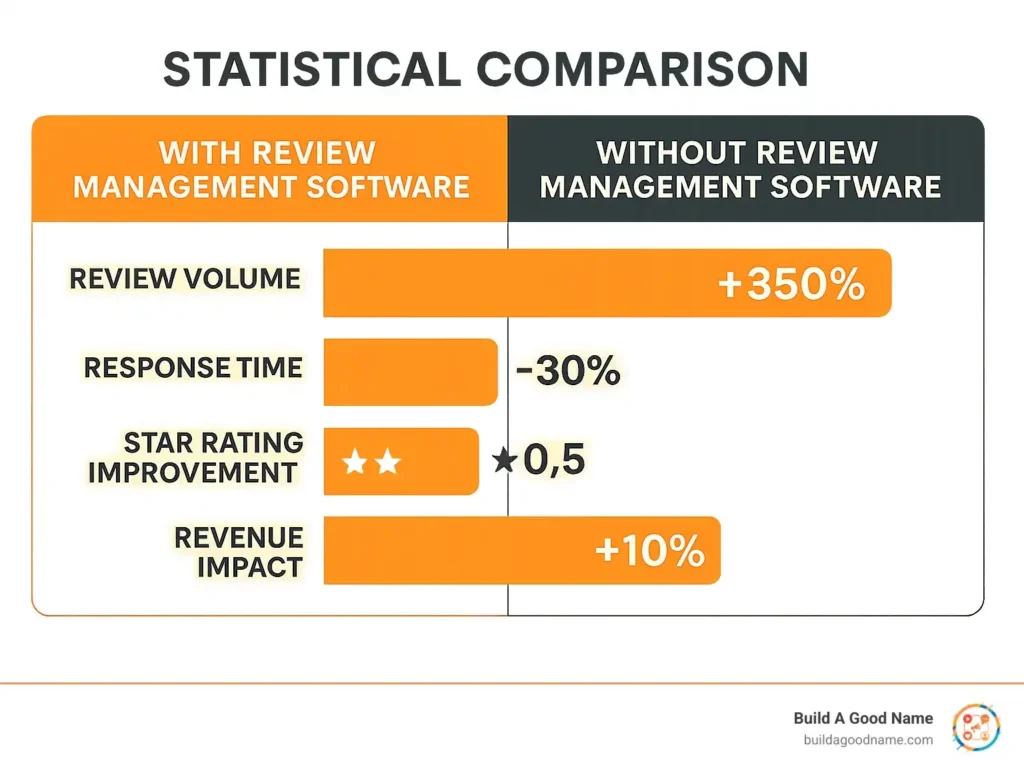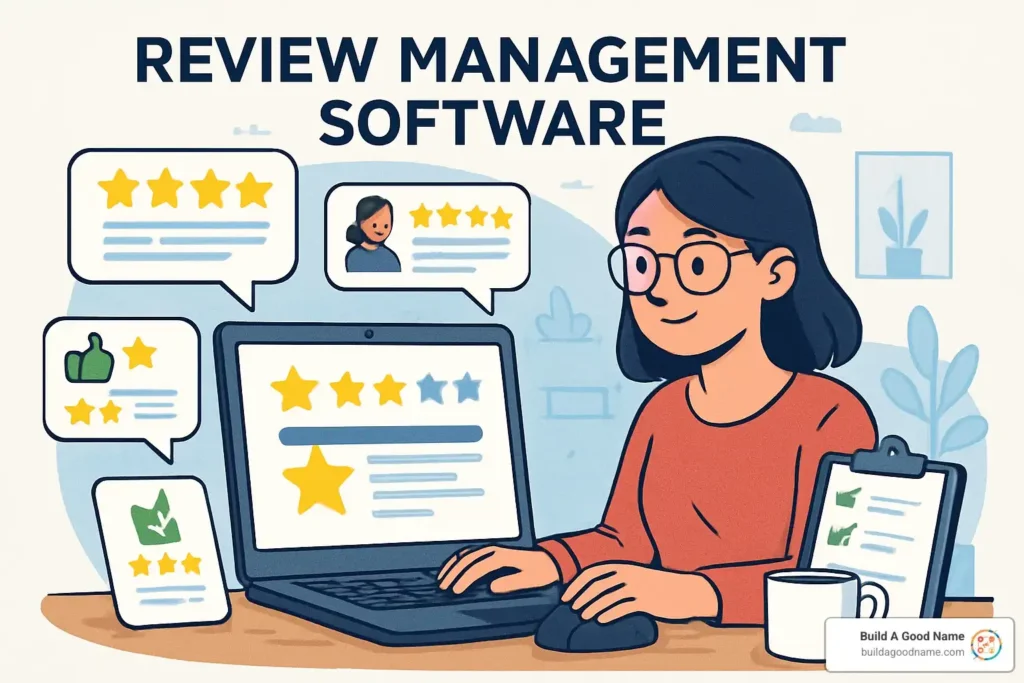Why Your Business Needs Review Management Software Right Now
Review management software helps businesses monitor, collect, and respond to customer reviews across multiple platforms from one central dashboard. Whether you’re drowning in scattered feedback or struggling to keep up with Google Reviews, these tools automate the heavy lifting so you can focus on running your business.
Here’s the reality: 88% of consumers trust online reviews as much as personal recommendations. That means your reputation isn’t just important – it’s everything.
One marketing professional who tested hundreds of review platforms put it perfectly: “Working at G2 has made one thing abundantly clear to me: reviews are the backbone of smart decisions.”
The numbers back this up. Research shows a one-star increase can boost sales by 5-9%, while review stars can increase click-through rates by up to 35%. Companies implementing proper review management have seen dramatic improvements in review volume and customer engagement.
But here’s what most business owners miss: it’s not just about collecting more reviews. It’s about turning that feedback into fuel for growth – something that’s nearly impossible to do manually when you’re juggling everything else.

The Rise of Customer Voice
The shift toward customer-driven purchasing decisions has fundamentally changed how businesses operate. Nearly half of consumers now research businesses online before making any purchase decision, and the credibility gap between traditional advertising and peer recommendations has never been wider.
Harvard research confirms what we’ve all suspected: star ratings directly correlate with business performance. The data shows that 85% of buyers trust online reviews as much as personal recommendations, making your online reputation a critical business asset rather than just a nice-to-have marketing tool.
What’s particularly striking is how younger consumers behave. Many consumers aged 18-24 expect to see more than 200 reviews before they’ll trust a product or service. This isn’t just about quantity – it’s about social proof at scale.
What You’ll Learn in This Guide
We’ve tested and analyzed dozens of review management platforms to help you find the right solution for your business. This guide covers everything from basic monitoring tools to enterprise-level reputation management systems.
You’ll find specific buyer criteria that matter most, implementation strategies that actually work, and real-world examples of businesses that transformed their online presence using these tools. Whether you’re a solo entrepreneur or managing multiple locations, we’ll help you steer the options without getting overwhelmed by feature lists and marketing speak.
Why Review Management Software Matters in 2025
The truth is, your brand reputation isn’t something you control anymore. Every customer interaction that ends up online shapes how people see your business, and those perceptions directly impact your bottom line.
Review management software has become essential because it transforms scattered customer feedback into a strategic advantage. Instead of scrambling to respond to reviews across different platforms, you get a clear picture of what customers really think – and more importantly, you can do something about it.
The revenue impact hits immediately. When potential customers search for your business, they’re not just glancing at your star rating. They’re reading recent reviews, checking how you handle complaints, and making snap judgments about whether they want to work with you. This whole process happens in about 30 seconds, and first impressions stick.
Here’s what really matters: crisis prevention beats damage control every time. The businesses that thrive don’t just react to bad reviews – they proactively build systems that prevent problems and turn happy customers into vocal advocates.
The local SEO benefits alone make this investment worthwhile. Google’s algorithm increasingly weighs review signals when deciding which businesses to show in local search results. More reviews and better ratings don’t just make you look good – they make you more visible when people search for what you offer.
Hard Numbers You Can’t Ignore
The research on review impact is pretty striking. A one-star increase can boost your sales by 5-9% – that’s real money, not just vanity metrics. This holds true across different industries and business sizes.
The click-through rate boost is even more dramatic. Studies tracking thousands of search results found that review stars can increase click-through rates by up to 35%. That means more people actually visit your website or call your business when they see those golden stars next to your listing.
But here’s the stat that should really grab your attention: 9 out of 10 people say online reviews influence their purchasing decisions. This isn’t a trend that might fade – it’s become the standard way customers make choices.
The companies that accept systematic review management see changeal results. AutoNation built over 1,000,000 five-star reviews and achieved a 148% increase in ROI. Greystar generated 36 more leads, 10 more leases, and $108,000 in added value per location. These aren’t lucky breaks – they’re what happens when you treat your online reputation as seriously as any other part of your business.

Review Management Software: How It Works & Must-Have Features
Think of review management software as your reputation command center. Instead of jumping from Google to Facebook to Yelp, one dashboard tracks everything and alerts you the moment new feedback appears. The better platforms even watch 80+ review sites, including niche directories most owners forget about.
Modern tools do more than collect comments—they interpret them. Built-in sentiment analysis flags complaints that need fast attention and highlights glowing testimonials you can showcase. Pair that with AI-drafted replies and you can acknowledge most reviews in seconds while still sounding human.

Other must-haves:
- Real-time mobile alerts so you can reply from anywhere.
- Automation rules that send review requests at the perfect time—no manual follow-ups.
- Website widgets that stream your best feedback for instant social proof.
- Actionable analytics that spot trends and measure ROI, not just track star averages.
Choosing Review Management Software: Key Criteria
- Scalability – A system that works for one location should still work for ten.
- Deep integrations over dozens of shallow ones – Prioritize airtight links to your CRM, POS, or e-commerce platform.
- Granular permissions – Let managers see everything while limiting front-desk staff to basic responses.
- True mobile apps – A responsive website is not the same as a full-featured app.
Review Management Software Pricing Models
| Model | Typical Cost | Best For |
|---|---|---|
| Freemium | $0–$20 /mo (limited features) | Testing the waters |
| Per-location | $7–$50 /location | Multi-location brands |
| Per-seat | $50–$250 /user | Centralized reputation teams |
| Usage-based | Varies | High-volume enterprises |
Whatever plan you choose, insist on transparent ROI tracking so you always know how each review request, response, or widget affects revenue.
The Best Review Management Software of 2025—5 Archetypes You Should Know
The review management software landscape has evolved into distinct categories, each optimized for different business needs and use cases. Rather than trying to be everything to everyone, the best platforms excel in specific areas while maintaining solid baseline functionality.

Understanding these archetypes helps you focus on solutions that align with your business model, team structure, and growth plans. Here’s how the market breaks down:
AI-Powered Solutions for Local Businesses
If you’re running a local business and feeling overwhelmed by the constant need to manage reviews, AI-powered review management software might be exactly what you need. These platforms are built with simplicity in mind, but don’t let that fool you – they pack serious automation power under the hood.
What makes these systems special is their intelligent timing. Instead of sending generic “please review us” messages at random times, they actually study your customer behavior patterns. A dental office might send review requests three days after a cleaning appointment, while a plumber might wait until a week after the job is finished. This smart timing can double or even triple your response rates.
The SMS campaign features are where these platforms really shine. Text messages get opened and read at rates that make email marketers weep with envy. We’re talking about response rates that are often 3-5 times higher than traditional email approaches. The best part? These aren’t just one-off review requests – they integrate texting throughout your entire customer journey.
Think about it this way: your customer gets a text confirming their appointment, another one when you’re on the way, and then a perfectly timed review request a few days later. It feels natural and personal, not pushy or automated.
Quick reply functionality is another game-changer for busy business owners. The AI analyzes each review and suggests multiple response options that match your brand voice. You can tweak the tone to be more formal or casual, then send personalized responses with just one click. It’s like having a customer service expert on your team 24/7.
The automated review invitations handle the heavy lifting of staying in touch with customers. Once you set up your preferences, the system keeps working in the background, sending requests at optimal times and following up appropriately. You’ll be amazed at how many more reviews you get when the process runs smoothly without you having to remember every single customer interaction.
Enterprise-Level Reputation Management
When you’re managing reputation across hundreds of locations or handling millions of customer interactions, you need review management software that can handle serious scale without breaking down. Enterprise platforms are built differently – they’re designed for the complexity that comes with big operations.
These systems don’t just watch review sites. They pull in feedback from everywhere your customers might be talking – social media mentions, survey responses, support tickets, even the sentiment from recorded phone calls. It’s like having a massive listening post that catches every whisper about your brand across the internet.
Multi-source feeds create a complete picture that single-channel monitoring simply can’t match. You might find that customers complain about wait times on Facebook but praise your product quality on Google. Or that support ticket themes predict which locations will see negative reviews next week. These connections become obvious once you can see all the data in one place.
The real magic happens with predictive analytics. Instead of just telling you what already happened, these platforms forecast what’s coming next. They can spot which locations are trending toward reputation problems before the bad reviews actually appear. Some systems even identify customers who are likely to leave negative feedback based on their interaction patterns, giving you a chance to reach out first.
Compliance controls become critical when you’re dealing with regulated industries. Healthcare companies need HIPAA-compliant review handling. Financial services require specific data retention policies. Enterprise platforms build these requirements into their core functionality rather than treating them as afterthoughts.
The KPI dashboards go way beyond basic star ratings. You might track how reputation improvements drive lead generation, or measure how review response strategies affect customer retention. These aren’t vanity metrics – they’re business intelligence that connects reputation management directly to revenue outcomes.
What separates enterprise solutions is their ability to handle massive complexity while still being usable by your team. The best platforms make sophisticated analytics feel simple, turning overwhelming data streams into clear action items your managers can actually use.
E-commerce Review Solutions
Online stores face a unique challenge: turning anonymous browsers into confident buyers. Review management software designed for e-commerce tackles this head-on by changing customer feedback into powerful sales tools that work around the clock.
The magic happens at the moment of truth – when someone’s hovering over that “Add to Cart” button. Product review widgets do much more than show a simple star rating. The smartest systems display recent reviews with photos, let customers filter feedback by product features, and highlight verified purchase badges. It’s like having your happiest customers personally recommend products to every website visitor.
But here’s where it gets really interesting: user-generated content syndication. Your reviews don’t just sit on your website gathering digital dust. They travel across the web, appearing on retailer sites, comparison shopping engines, and social media platforms. When customers see consistent positive feedback everywhere they look, trust builds naturally.
The Google seller ratings integration can be a game-changer for your paid advertising. When your Google ads show those golden star ratings, click-through rates typically jump 10-20%. People instinctively trust businesses with visible social proof, and those stars act like a guide in crowded search results.
SEO schema markup ensures search engines understand your review data perfectly. This translates into rich snippets that make your listings stand out in search results. Instead of plain text, potential customers see star ratings, review counts, and price information right in their Google search – making your business look more established and trustworthy than competitors with basic listings.
The best e-commerce platforms also sync with your inventory system, automatically requesting reviews when orders are delivered and highlighting product-specific feedback that helps other customers make informed decisions. It’s reputation management that directly drives revenue.
Service Business Management Tools
Service businesses face unique challenges when it comes to review management software. Unlike retail stores or restaurants, you’re dealing with appointments, field technicians, and complex project timelines. The timing of when you ask for reviews can make or break your success rate.
The best platforms for service businesses understand this reality. They integrate directly with your scheduling software and job management systems, creating a seamless flow from completed work to happy customer reviews. No more sticky notes reminding you to follow up, no more missed opportunities because someone forgot to send a review request.
Field-service integrations are where these platforms really shine. Picture this: your HVAC technician finishes installing a new system and marks the job complete in your field software. Within minutes, the system automatically captures the customer’s contact information and service details, then schedules a perfectly timed review request. No manual data entry, no chance for human error.
The timing intelligence is particularly smart. A plumbing company might send their first review request 24 hours after completing an emergency repair – enough time for the customer to appreciate that their bathroom works again. Meanwhile, a roofing contractor might wait until final payment clears and they know the customer is completely satisfied with the project.
Job-completion triggers can be customized based on your specific business needs. Different service types get different timing. VIP customers might get a personal phone call before any automated requests. Large commercial projects might trigger a multi-step follow-up sequence that includes the project manager, account representative, and customer success team.
This is where texting workflows become incredibly powerful for service businesses. Your customers are busy people who hired you to solve a problem. They don’t want to hunt through their email to find your review request. A simple, well-timed text message gets much better response rates.
Industry-Specific Solutions
Some businesses need more than generic review management software – they need platforms built specifically for their industry’s unique challenges. Whether it’s healthcare privacy laws, automotive sales cycles, or hospitality guest experiences, specialized solutions understand the nuances that make or break customer relationships.
Healthcare platforms go way beyond basic HIPAA compliance. They understand that patient reviews require careful consent management and secure communication channels that protect sensitive information. The best systems integrate directly with electronic health records, automatically triggering review requests when treatments are completed – but only after proper patient authorization.
Think about it: a dental office can’t just blast out review requests like a pizza shop. They need systems that respect patient privacy while still encouraging feedback from satisfied patients. These specialized platforms handle all the legal complexity so healthcare providers can focus on patient care.
Automotive platforms recognize that buying a car is completely different from ordering dinner. Car buyers research for weeks or months, visiting multiple dealerships and comparing dozens of options. These systems integrate with dealer management systems to track customers through long sales cycles, sending targeted review requests at exactly the right moments.
A customer who just bought their dream car is in a very different mindset than someone still shopping around. Industry-specific platforms understand these emotional journeys and time their outreach accordingly.
Hospitality systems handle the incredible complexity of guest experiences. Between reservation, check-in, dining, activities, and check-out, there are dozens of touchpoints that can make or break a stay. These platforms trigger different review campaigns based on guest behavior and real-time satisfaction scores collected throughout their visit.
Professional services like law firms, accounting practices, and consulting businesses have their own unique needs. These businesses need integration with industry-specific review sites and directories where their actual customers are making decisions.
Industry-specific platforms understand these ecosystems completely. They don’t just monitor the obvious sites – they track the specialized directories and platforms where your actual customers are making decisions. This comprehensive coverage often reveals reputation opportunities that generic tools miss entirely.
Key Benefits & Best Practices
Rolling out review management software pays off in three big ways: higher trust, better search visibility, and a steady feedback loop that keeps customers coming back. When reviews flow into one place—and responses go out just as fast—you turn scattered comments into a roadmap for growth.

Automate but Personalize
AI can draft responses in seconds, but a quick edit keeps your brand voice intact. The best systems learn your tone over time and even translate replies so customers see answers in their native language.
Turn Reviews into Marketing Assets
- Embed review widgets on landing pages and product pages to lift conversions.
- Auto-share 5-star feedback to social channels—graphics included.
- Use schema markup so those gold stars appear in Google search results.
Handle Negativity Proactively
- Instant alerts highlight low ratings or specific keywords so nothing slips through the cracks.
- Route each issue to the right person—billing problems to accounting, service complaints to the field team.
- After resolving the problem, politely ask the customer to update their review; many will.
Treat every comment—good or bad—as a chance to demonstrate great service. Over time, your star rating climbs, churn drops, and referrals rise without any extra ad spend.
Frequently Asked Questions about Review Management Software
How does review management software improve SEO?
Fresh reviews create constant, keyword-rich content that search engines love. When your platform adds the correct structured data markup, Google can display star ratings right in search results, increasing click-through rates. Plus, Google factors review volume, rating, and response speed into local rankings—so the more active you are, the higher you show up in “near me” searches.
What integrations should I look for?
- CRM – feeds review sentiment directly into customer profiles.
- POS or scheduling system – triggers automatic review requests after purchases or appointments.
- E-commerce platform – syncs product ratings, inventory, and order data.
- Social APIs – turn positive reviews into posts without extra work.
Solid connections with these core tools matter more than having dozens of superficial integrations you never use.
Are there low-cost or free options for small businesses?
Yes. Many providers offer freemium plans for one location with limited features, and almost all reputable platforms include a 14–30-day free trial. Open-source tools exist if you have technical chops, but paid plans usually pay for themselves with a handful of new customers. Start small, prove the ROI, then upgrade when you outgrow the basics.
Conclusion
The ROI from effective review management software goes way beyond prettier star ratings on your Google listing. We’re talking about real business impact – lower customer acquisition costs, higher lifetime value, and the kind of organic search visibility that brings customers to your door without paid ads. The magic happens when you pick a platform that actually fits how your business works and grows with you over time.
Here’s where you should start: take a hard look at your current review situation across all the platforms where customers might be talking about you. You’ll probably find gaps in what you’re monitoring, inconsistent responses (or no responses at all), and missed opportunities to collect feedback from happy customers.
Don’t get distracted by fancy feature lists or whoever has the lowest price. Focus on what you actually need to solve your specific problems.
At BuildAGoodName, we get it – managing online reviews can feel like drinking from a fire hose when you’re already juggling everything else in your business. That’s exactly why we built our AI-powered platform to handle the heavy lifting while keeping that personal touch that turns customers into raving fans. We help local businesses transform customer feedback from a source of stress into their secret competitive weapon.
The businesses crushing it in 2025 understand something important: customer feedback isn’t just something you have to deal with – it’s pure gold for growing your business. Reputation management plays a crucial role in building customer trust and creating the kind of sustainable growth that doesn’t depend on constantly finding new customers.
Start simple. Pick one platform, implement it properly, and actually measure what changes. Don’t try to do everything at once. The change in how customers perceive and interact with your business will pay for itself many times over – and probably faster than you think.



